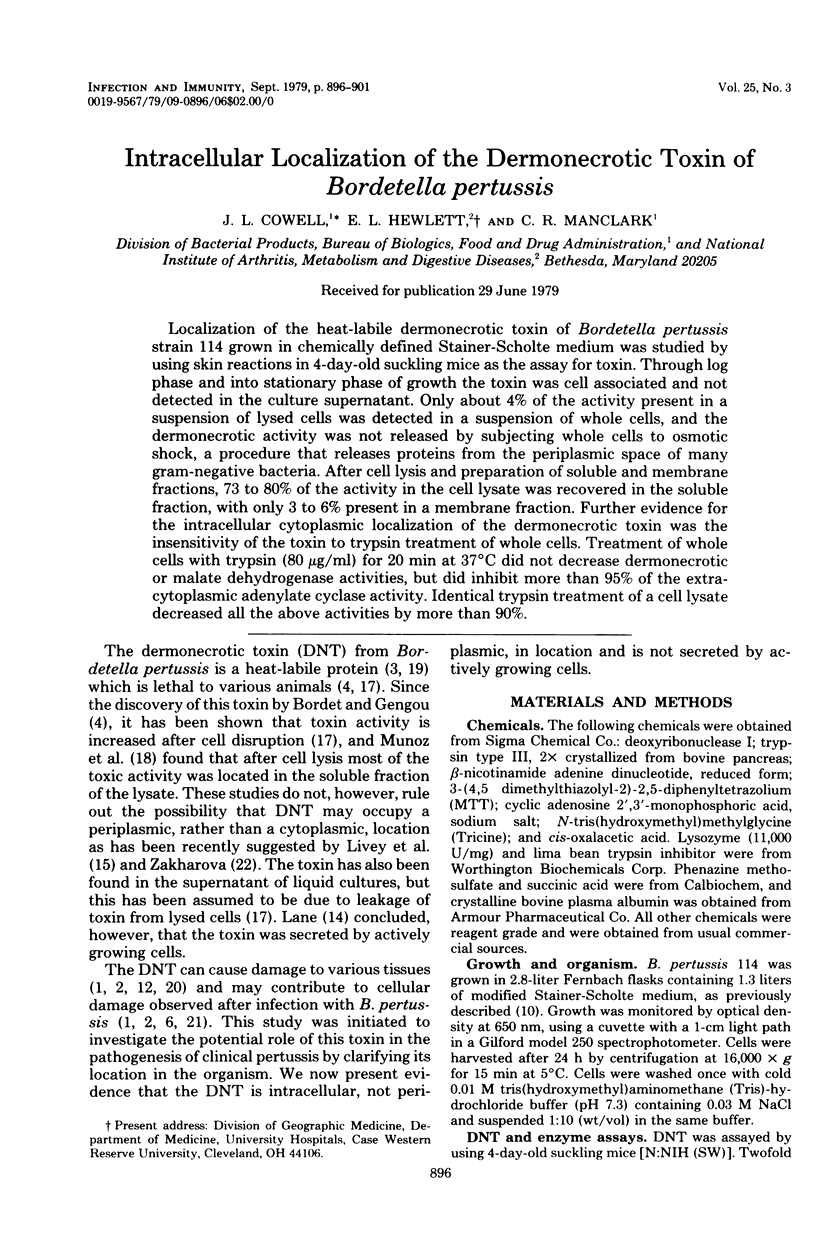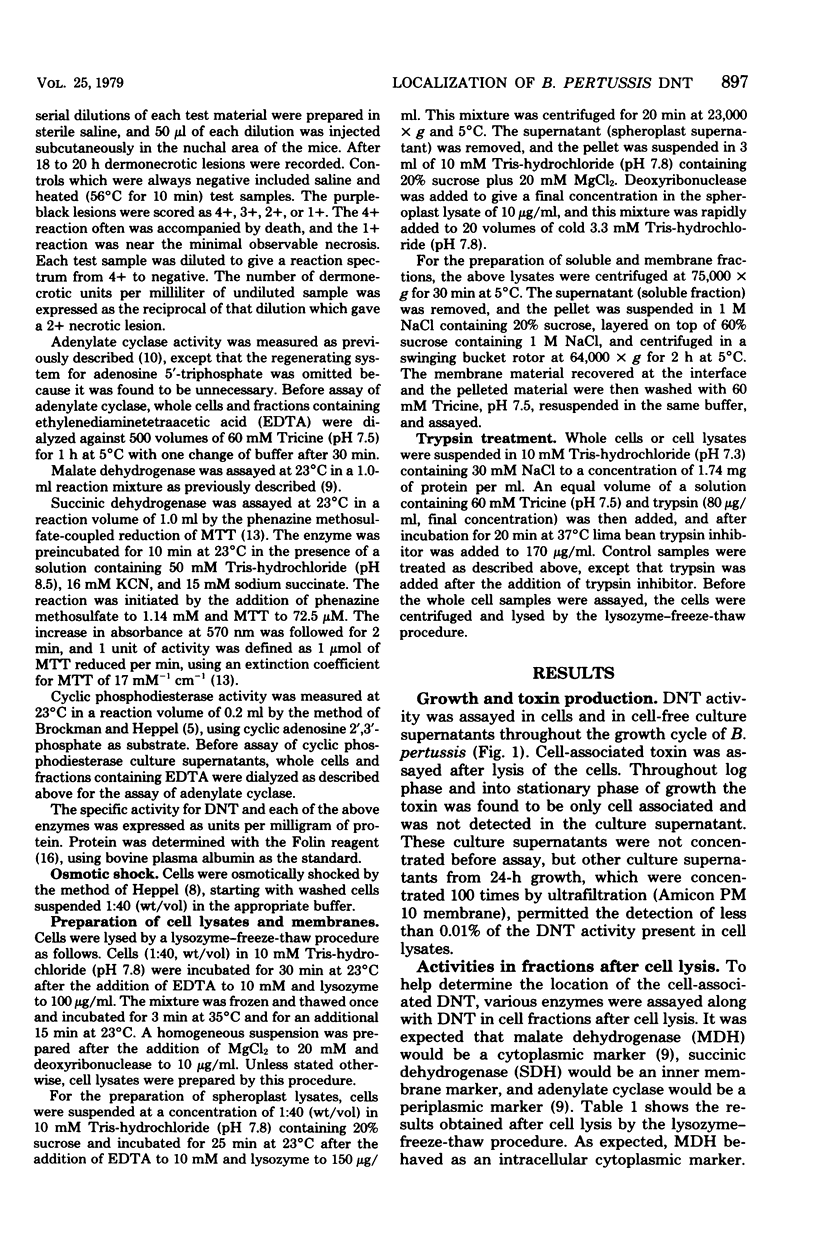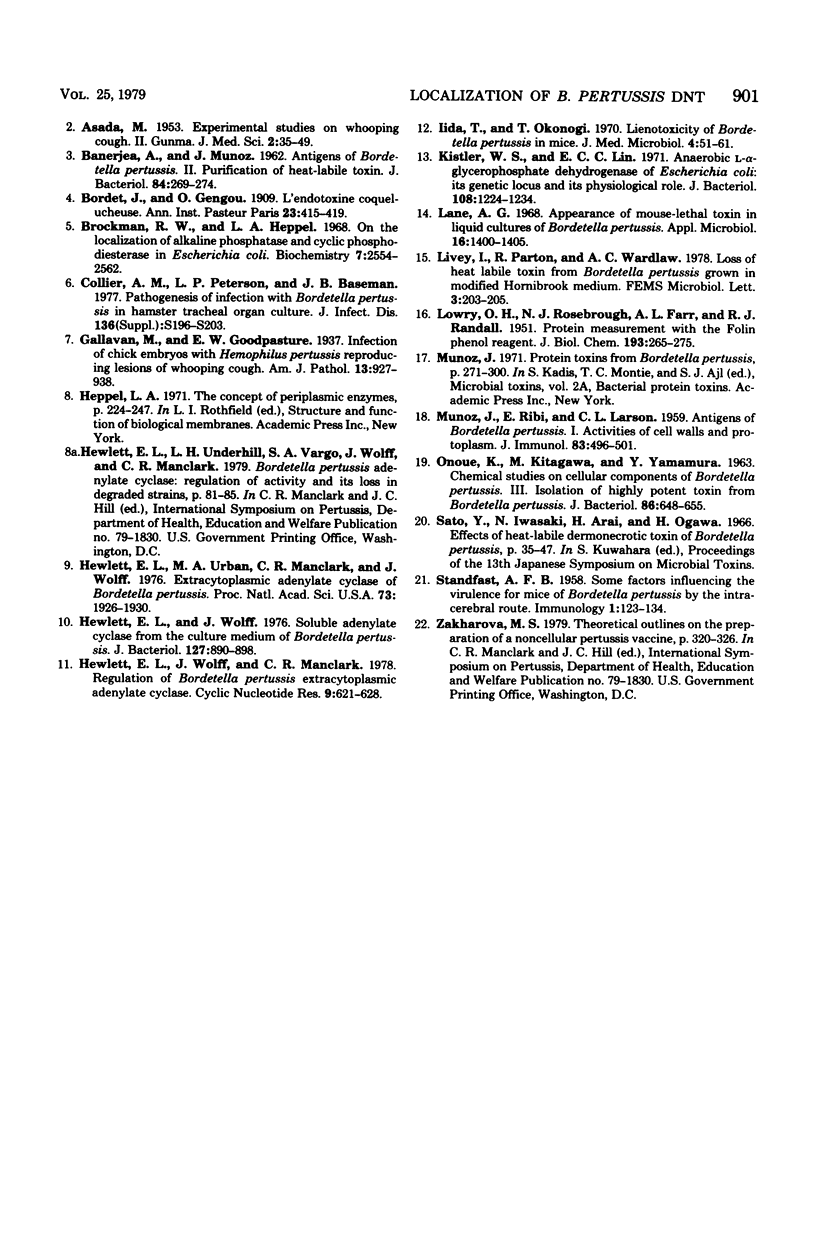Abstract
Localization of the heat-labile dermonecrotic toxin of Bordetella pertussis strain 114 grown in chemically defined Stainer-Scholte medium was studied by using skin reaction in 4-day-old suckling mice as the assay for toxin. Through log phase and into stationary phase of growth the toxin was cell associated and not detected in the culture supernatant. Only about 4% of the activity present in a suspension of lysed cells was detected in a suspension of whole cells, and the dermonecrotic activity was not released by subjecting whole cells to osmotic shock, a procedure that releases proteins from the periplasmic space of many gram-negative bacteria. After cell lysis and preparation of soluble and membrane fractions, 73 to 80% of the activity in the cell lysate was recovered in the soluble fraction, with only 3 to 6% present in a membrane fraction. Further evidence for the intracellular cytoplasmic localization of the dermonecrotic toxin was the insensitivity of the toxin to trypsin treatment of whole cells. Treatment of whole cells with trypsin (80 micrograms/ml) for 20 min at 37 degrees C did not decrease dermonecrotic or malate dehydrogenase activities, but did inhibit more than 95% of the extra-cytoplasmic adenylate cyclase activity. Identical trypsin treatment of a cell lysate decreased all the above activities by more than 90%.
Full text
PDF





Selected References
These references are in PubMed. This may not be the complete list of references from this article.
- BANERJEA A., MUNOZ J. Antigens of Bordetella pertussis. II. Purification of heat-labile toxin. J Bacteriol. 1962 Aug;84:269–274. doi: 10.1128/jb.84.2.269-274.1962. [DOI] [PMC free article] [PubMed] [Google Scholar]
- Brockman R. W., Heppel L. A. On the localization of alkaline phosphatase and cyclic phosphodiesterase in Escherichia coli. Biochemistry. 1968 Jul;7(7):2554–2562. doi: 10.1021/bi00847a016. [DOI] [PubMed] [Google Scholar]
- Collier A. M., Peterson L. P., Baseman J. B. Pathogenesis of infection with Bordetella pertussis in hamster tracheal organ culture. J Infect Dis. 1977 Aug;136 (Suppl):S196–S203. doi: 10.1093/infdis/136.supplement.s196. [DOI] [PubMed] [Google Scholar]
- Gallavan M., Goodpasture E. W. Infection of Chick Embryos with H. Pertussis Reproducing Pulmonary Lesions of Whooping Cough. Am J Pathol. 1937 Nov;13(6):927–938.7. [PMC free article] [PubMed] [Google Scholar]
- Hewlett E. L., Urban M. A., Manclark C. R., Wolff J. Extracytoplasmic adenylate cyclase of Bordetella pertussis. Proc Natl Acad Sci U S A. 1976 Jun;73(6):1926–1930. doi: 10.1073/pnas.73.6.1926. [DOI] [PMC free article] [PubMed] [Google Scholar]
- Hewlett E. L., Wolff J., Manclark C. R. Regulation of Bordetella pertussis extracytoplasmic adenylate cyclase. Adv Cyclic Nucleotide Res. 1978;9:621–628. [PubMed] [Google Scholar]
- Hewlett E., Wolff J. Soluble adenylate cyclase from the culture medium of Bordetella pertussis: purification and characterization. J Bacteriol. 1976 Aug;127(2):890–898. doi: 10.1128/jb.127.2.890-898.1976. [DOI] [PMC free article] [PubMed] [Google Scholar]
- Iida T., Okonogi T. Lienotoxicity of Bordetella pertussis in mice. J Med Microbiol. 1971 Feb;4(1):51–61. doi: 10.1099/00222615-4-1-51. [DOI] [PubMed] [Google Scholar]
- Kistler W. S., Lin E. C. Anaerobic L- -glycerophosphate dehydrogenase of Escherichia coli: its genetic locus and its physiological role. J Bacteriol. 1971 Dec;108(3):1224–1234. doi: 10.1128/jb.108.3.1224-1234.1971. [DOI] [PMC free article] [PubMed] [Google Scholar]
- LOWRY O. H., ROSEBROUGH N. J., FARR A. L., RANDALL R. J. Protein measurement with the Folin phenol reagent. J Biol Chem. 1951 Nov;193(1):265–275. [PubMed] [Google Scholar]
- Lane A. G. Appearance of mouse-lethal toxin in liquid cultures of Bordetella pertussis. Appl Microbiol. 1968 Sep;16(9):1400–1405. doi: 10.1128/am.16.9.1400-1405.1968. [DOI] [PMC free article] [PubMed] [Google Scholar]
- MUNOZ J., RIBI E., LARSON C. L. Antigens of Bordetella pertussis. I. Activities of cell walls and protoplasm. J Immunol. 1959 Nov;83:496–501. [PubMed] [Google Scholar]
- ONOUE K., KITAGAWA M., YAMAMURA Y. CHEMICAL STUDIES ON CELLULAR COMPONENTS OF BORDETELLA PERTUSSIS. III. ISOLATION OF HIGHLY POTENT TOXIN FROM BORDETELLA PERTUSSIS. J Bacteriol. 1963 Oct;86:648–655. doi: 10.1128/jb.86.4.648-655.1963. [DOI] [PMC free article] [PubMed] [Google Scholar]
- STANDFAST A. F. Some factors influencing the virulence for mice of Bordetella pertussis by the intracerebral route. Immunology. 1958 Apr;1(2):123–134. [PMC free article] [PubMed] [Google Scholar]


